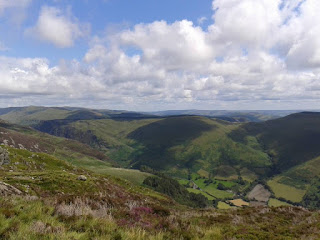But I've already done the other two, so on this occasion my Eldest and I will attempt to add this behemoth to our list of conquered summits.
We have opted to take the Minffordd path, which begins close to a car park and visitor centre/cafe just off the A487. The rest of our party have opted to remain at the base, so only two of us - armed with water bottles and enthusiasm - set off on the steep ascent, steps climbing up into a gorgeous waterfall valley. Eldest, as usual, has a keen eye for the flora and fauna surrounding us on this arboreal section of the journey.
 |
| Butterwort, a carniverous plant |
 |
| Common Lizard, not camera shy. |
Tongues of fire on Idris flaring,
News of foe-men near declaring,
To heroic deeds of daring,
Call you Harlech men.
- 'Men Of Harlech'
Idris is a giant in Welsh mythology, but he seems to have been based on a real historical figure - Idris ap Gwyddno, a king of Meirionydd active in the late sixth and early seventh centuries. The summit of the mountain, Penygadair, the neighbouring 'saddle' and the adjacent peak of Tyrau Mawr are said to form his chair, hence the mountain's name. Boulders at the foot of the mountain are said to be stones shaken out of the giant's shoe, and any who spend the night on the peak will wake as either a poet or a madman.
It is also the hunting ground of Gwyn Ap Nudd, Lord of Annwn (the Celtic Underworld). The howling of his dogs, the Cwn Annwn, are said to foretell death to those who hear it.
 |
| Penygadair, the peak of Cadair Idris |
Below us lies the icy blue water of Llyn Cau. The crater in which it lays has given rise to the mistaken belief that Cadair Idris is an extinct volcano, whereas it is in fact glacial, carved by a cirque glacier during the most recent ice age.
 |
| Llyn Cau |
 |
| Quartz veins |
 |
| The summit, 896m/2930ft, 'Penygadair' |
Now the descent. We amble along the ridge until... it just kind of stops. Below us, a set of uneven steps disappear into the valley.
The steep valley.
Treacherous, slippery steps which vanish when they reach rock provide our route down from the ridge. Over a mile of them. We are actually quite grateful when we reach the treeline in one piece and descend into our waterfall valley.
Our companions, left behind at the Visitor Centre, inform us that we have been gone for four hours, which tells us that Cadair Idris took us an hour and a half longer to climb up and down than Pen Y Fan two years ago.
We drove away, heading towards our campsite in Shropshire, managing to miss a local monument which, at the time, we knew nothing about - the ruins of Mary Jones' Cottage. In the year 1800, the sixteen-year-old Mary walked barefoot from her home at the foot of the mountain to Lake Bala, twenty-eight miles away, to buy a Bible from the Reverend Thomas Charles. This feat inspired Charles to form the British and Foreign Bible Society, with its aim of supplying remote areas with Bibles. A memorial obelisk stands on the ruins of Mary's home, and a 'Mary Jones World' exists at Bala.
As we drive east, out of Snowdonia and into the Cambrians, the Chair Of Idris is gradually obscured by intervening peaks. We have walked in the realms of giants, of underworld hunts, and pious maidens with extreme fortitude, and emerged tired but intact.
Until the next lofty peak calls to us...
all pictures (c) Charlie McManus


